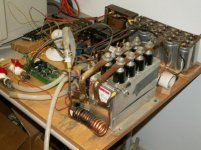dgfoster
Diamond
- Joined
- Jun 14, 2008
- Location
- Bellingham, WA
Right up front I will confess that my knowledge concerning electronics, switching transistors and induction furnace design and operation is woefully inadequate. That said, my ignorance may be partially curable.
I am interested in building an induction furnace capable of melting 60 pounds of iron over a few hours time. I am very aware that their are any number of commercial units with capacities ranging in size from a pound or two of iron to a few tons. Units available in whatever size are usually designed to melt the charge in under one hour. While that is convenient and desirable, that short melt time is not necessarily essential. To achieve short melt times very large power inputs are required. I believe the required energy input to melt 1 ton of iron is roughly 500 KWH. So, to melt 50 pounds would require 25 KWH. If an ideal furnace could be designed (I think I have a fair handle on refractory insulation and general furnace design as I am currently using diesel to melt iron in a shop-made furnace and have been doing this for about 1 year.), I will assume that for the sake of discussion that a 5KW induction heater run over 5 hours might melt iron in 5 hours. (I know this is not a real world assumption but want to keep the question focused on the induction side of things.)
So, my question is how difficult and expensive would it be to design and build a 5KW 1000Hz power supply and heater coil? Is this potentially feasible and reasonably economical or am I tilting at windmills? Economical might mean 1000 dollars or less. Are there simple options I am overlooking for power supplies that might be re-purposed for my intended application? Is the obvious answer to just buy one of these and hook it up to an appropriately sized---9" diameter roughly---coil housed in a well-insulated furnace?
New 5KW 100~250KHz High Frequency Induction Heater Furnace Fast Shipping | eBay
Trying to reduce my ignorance,
Denis
PS The iron is used to cast camel back straight edges and prisms of my own design for sale for use in reconditioning precision machinery and equipment. Those castings range in weight from 20 pounds to close to 60 pounds.
I am interested in building an induction furnace capable of melting 60 pounds of iron over a few hours time. I am very aware that their are any number of commercial units with capacities ranging in size from a pound or two of iron to a few tons. Units available in whatever size are usually designed to melt the charge in under one hour. While that is convenient and desirable, that short melt time is not necessarily essential. To achieve short melt times very large power inputs are required. I believe the required energy input to melt 1 ton of iron is roughly 500 KWH. So, to melt 50 pounds would require 25 KWH. If an ideal furnace could be designed (I think I have a fair handle on refractory insulation and general furnace design as I am currently using diesel to melt iron in a shop-made furnace and have been doing this for about 1 year.), I will assume that for the sake of discussion that a 5KW induction heater run over 5 hours might melt iron in 5 hours. (I know this is not a real world assumption but want to keep the question focused on the induction side of things.)
So, my question is how difficult and expensive would it be to design and build a 5KW 1000Hz power supply and heater coil? Is this potentially feasible and reasonably economical or am I tilting at windmills? Economical might mean 1000 dollars or less. Are there simple options I am overlooking for power supplies that might be re-purposed for my intended application? Is the obvious answer to just buy one of these and hook it up to an appropriately sized---9" diameter roughly---coil housed in a well-insulated furnace?
New 5KW 100~250KHz High Frequency Induction Heater Furnace Fast Shipping | eBay
Trying to reduce my ignorance,
Denis
PS The iron is used to cast camel back straight edges and prisms of my own design for sale for use in reconditioning precision machinery and equipment. Those castings range in weight from 20 pounds to close to 60 pounds.



